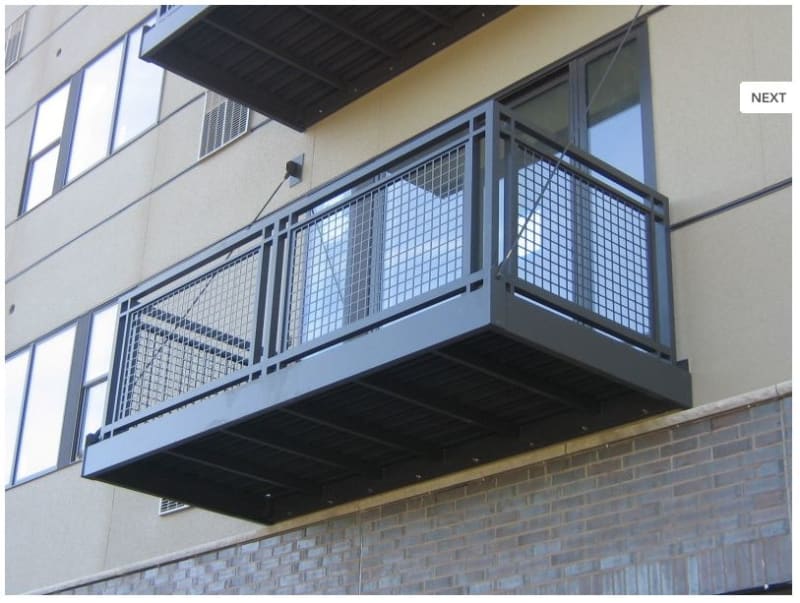structural-eng
Structural
We have been designing prefabricated aluminum decks for a local fabricator for a few years now. If you drive around any metropolitan area you have assuredly seen hundreds of these decks as they are all over mid-level wood constructed housing units. You know, the ones with the hanger rods at the outer corners that go back to the building wall.
We have always designed for 60 psf live load (1.5x occupancy served), flat roof snow (for an unheated surface) plus snow drift and for uplift. The only thing that the uplift governs for is the hanger rods as it puts them in compression. Our client has tried getting us to allow 3/4" diameter rods for the hangers on numerous occasions claiming that ALL the competition uses 3/4" diameter rods. The rods are typically A36 steel or stainless steel (they take care of the dissimilar metals condition at the yoke. We have never been able to justify 3/4" diameter rods. We have always used 1" diameter. Even at an net uplift pressure of 20 psf the compression in the rods is about 260#. The rods vary in length/angle but the last one we did the rods were 128" and you can't get 260# out of a 3/4" diameter rod that long.
I'm curious if anyone has any insight on how other manufacturers can be justifying 3/4" diameter rods? I've seen drawings for 2 other companies and they do use them. We talked about this in house numerous times and believe it's very possible they are neglecting to consider the uplift case but we don't believe that is acceptable.
The other drawings I saw showed the ledger with prefabricated holes at a given layout and it was the purchasers responsibility to ensure there was adequate backup for attachment. I'm pretty sure with the competition deck no one actually designed the fastener that connects the deck they are buying to the building. I've been doing these long enough to know that rarely does the same connection location work on 2 different buildings because of how the exterior walls are framed at the floor levels. We adjust the layout and fastener type to work with the way the building is framed for each project. This lack of attention to detail by the competition just adds to my belief that they aren't considering uplift. Maybe I'm wrong. I would love it if someone corrected me and pointed out some snip in the code that said the uplift condition could be neglected for these decks but I'd be surprised if that was the case.
Thank you.
We have always designed for 60 psf live load (1.5x occupancy served), flat roof snow (for an unheated surface) plus snow drift and for uplift. The only thing that the uplift governs for is the hanger rods as it puts them in compression. Our client has tried getting us to allow 3/4" diameter rods for the hangers on numerous occasions claiming that ALL the competition uses 3/4" diameter rods. The rods are typically A36 steel or stainless steel (they take care of the dissimilar metals condition at the yoke. We have never been able to justify 3/4" diameter rods. We have always used 1" diameter. Even at an net uplift pressure of 20 psf the compression in the rods is about 260#. The rods vary in length/angle but the last one we did the rods were 128" and you can't get 260# out of a 3/4" diameter rod that long.
I'm curious if anyone has any insight on how other manufacturers can be justifying 3/4" diameter rods? I've seen drawings for 2 other companies and they do use them. We talked about this in house numerous times and believe it's very possible they are neglecting to consider the uplift case but we don't believe that is acceptable.
The other drawings I saw showed the ledger with prefabricated holes at a given layout and it was the purchasers responsibility to ensure there was adequate backup for attachment. I'm pretty sure with the competition deck no one actually designed the fastener that connects the deck they are buying to the building. I've been doing these long enough to know that rarely does the same connection location work on 2 different buildings because of how the exterior walls are framed at the floor levels. We adjust the layout and fastener type to work with the way the building is framed for each project. This lack of attention to detail by the competition just adds to my belief that they aren't considering uplift. Maybe I'm wrong. I would love it if someone corrected me and pointed out some snip in the code that said the uplift condition could be neglected for these decks but I'd be surprised if that was the case.
Thank you.

